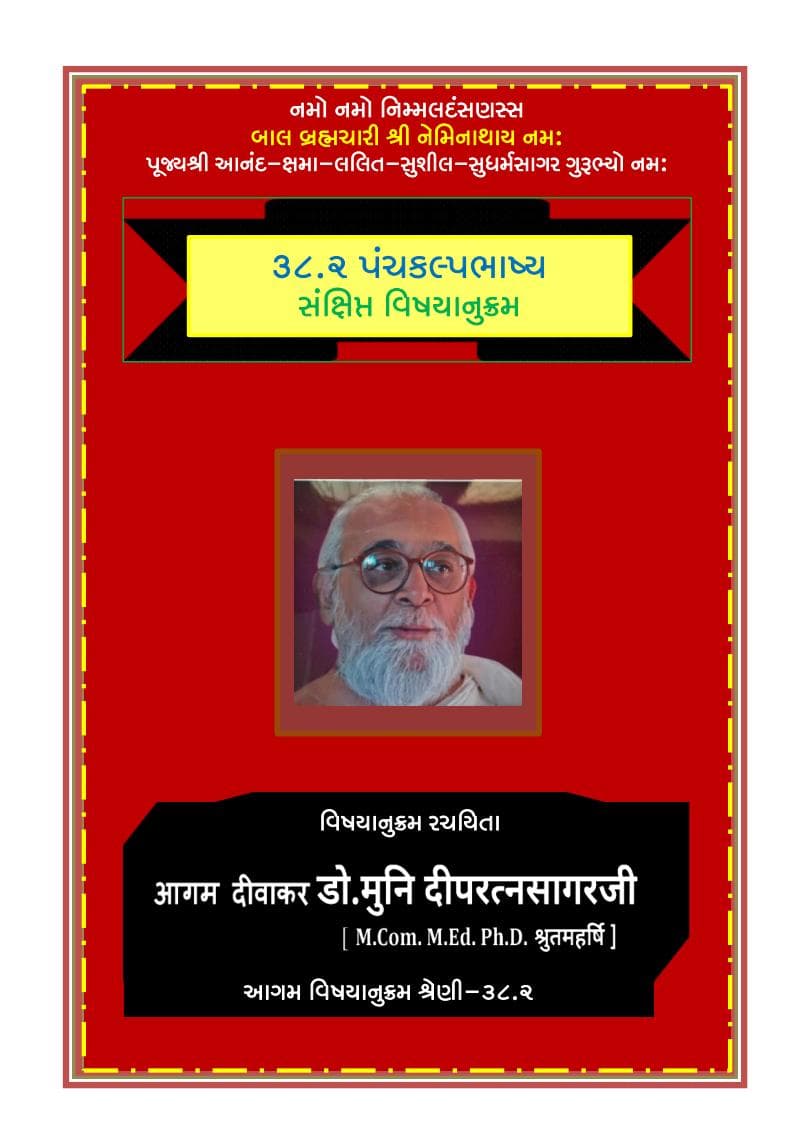38 02 Panchkalpa Satik Vishayanukram
Added to library: September 1, 2025

Summary
Based on the provided catalog link and the title "38 02 Panchkalpa Satik Vishayanukram" by Dipratnasagar, Deepratnasagar, here's a comprehensive summary of what this Jain text likely contains:
Title Breakdown:
- Panchkalpa (पंचकल्प): This is the core subject matter. "Pancha" means five, and "Kalpa" can refer to a rule, ritual, vow, or practice. Therefore, "Panchkalpa" likely refers to a set of five fundamental principles, practices, or vows central to Jainism. These are typically the five core vows (Mahavratas) observed by monks and ascetics, and often their milder forms (Anuvratas) by laypeople.
- Satik (सातिक): This indicates the presence of a commentary or explanation (Tika) of the Panchkalpa. It implies the text is not just a recitation of the principles but also provides an in-depth elaboration and justification.
- Vishayanukram (विषयानुक्रम): This translates to an index or table of contents, suggesting that the book is structured and organized, guiding the reader through the various topics covered in the commentary on the Panchkalpa.
Publisher: Dipratnasagar, Deepratnasagar (This indicates the author is also the publisher, suggesting a personal or authoritative rendition of the text.)
Likely Content and Purpose:
The "38 02 Panchkalpa Satik Vishayanukram" is almost certainly a scholarly and detailed exposition of the five principal tenets of Jainism, accompanied by an extensive commentary and an organized index.
Here's a more detailed breakdown of the probable content:
-
Introduction to the Panchkalpa: The book would likely begin with an introduction to the significance of the Panchkalpa in Jain philosophy and practice. This might include:
- The origin and importance of these vows in attaining liberation (Moksha).
- The fundamental role they play in ethical conduct for both monastics and laypeople.
-
Detailed Exposition of Each of the Five Kalpas (Vows): The core of the book would be a thorough explanation of each of the five fundamental Jain vows:
- Ahimsa (Non-violence): This would be the most extensively discussed vow, covering its multifaceted aspects: mental, verbal, and physical violence. It would likely delve into the classification of violence (Samiti and Gupti), the rights of all living beings, and the practical application of non-violence in daily life.
- Satya (Truthfulness): Explanation of speaking the truth, the caveats of speaking hurtful truths, and the importance of truth in maintaining moral integrity.
- Asteya (Non-stealing/Non-covetousness): The principle of not taking what is not given, including a broader interpretation of not desiring what belongs to others.
- Brahmacharya (Chastity/Celibacy): This vow, particularly for monks and nuns, would be elaborated upon, focusing on controlling desires related to the senses and mind. For laypeople, it often refers to fidelity and moderation in conjugal life.
- Aparigraha (Non-possession/Non-attachment): The principle of renouncing excessive attachment to material possessions, worldly relationships, and even one's own body and mind. This vow emphasizes detachment and freedom from worldly entanglements.
-
The Commentary (Satik): The "Satik" portion signifies that each of the five Kalpas, and their various sub-points, would be explained and analyzed in detail. This commentary might include:
- Scriptural References: Citations from authoritative Jain scriptures (Agamas) that define and support these vows.
- Philosophical Justification: Explanations of the underlying philosophical reasons for each vow and their role in the path to liberation.
- Practical Application: Guidance on how to observe these vows in everyday life, including potential challenges and solutions.
- Classifications and Nuances: Detailed breakdowns of different types or degrees of observance for each vow, distinguishing between the Mahavratas (great vows of monks) and Anuvratas (minor vows of laypeople).
- Examples and Stories: Anecdotal evidence or stories from the lives of Jain saints and devout followers to illustrate the principles.
-
The Index (Vishayanukram): The presence of an index suggests a systematic organization of the material. This would allow readers to easily locate specific topics, verses, concepts, or scriptural references within the commentary. This is crucial for a comprehensive and scholarly work.
Target Audience:
This book is likely intended for:
- Jain Monks and Ascetics: As a foundational text for their spiritual discipline.
- Serious Jain Scholars and Students: Seeking a deep understanding of the core ethical framework of Jainism.
- Devout Jain Laypeople: Who wish to deepen their knowledge and practice of Jain principles in their daily lives.
In Essence:
The "38 02 Panchkalpa Satik Vishayanukram" is a profound and authoritative work that serves as a comprehensive guide to the five essential ethical and spiritual principles of Jainism, supported by a detailed commentary and structured with a helpful index. It aims to provide a thorough understanding of these vows and their practical implementation, contributing to the spiritual growth and adherence to the Jain path.